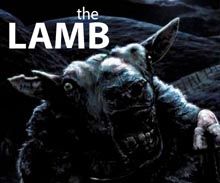The Damned (2024, directed by Thordur Palsson) is a film that shows the widening influence of Robert Eggers on cinema. Elements of all of Eggers's films can be spotted in this film, including the visual design of his recent version of Nosferatu. This is a film that dwells in cold and shadow, making extensive use of its bleak Iceland-in-winter location. One could see Anya Taylor-Joy in the lead in this film rather than Odessa Young, but Young is fine in the part of a woman running a remote fishing station in the 19th century. The screenplay is less disciplined than Eggers, though, including an ending that leaves the audience with questions. The rest? Claustrophobic and chilly, a crucible where close company in isolation fails to prevent anyone from going mad. Superstition runs roughshod over otherwise rational people.
The story takes place at a remote fishing station some time in the 1800s. The supplies are getting low on the season when first we meet Eva, the owner of the business, she is walking through their stocks of fish in the deep winter gloaming. This year's catch has been lean. They are down to eating their bait. Eva is a widow who ran the business with her late husband. She is no nonsense, but leaves the running of the actual fishing boats to her helmsman, Ragnar. The hands respect Eva, by and large, and defer to Ragnar. Eva keeps the station with the assistance of Helga, who has a tale to tell one night while the men are drinking around a fire about a revenant called a Draugr, who will stop at nothing to gain its vengeance on the living. The next day, the men spot a ship foundering against the rock spires called "The Teeth" across the bay. Some of the men want to row out to rescue any survivors, particularly Aron, who is a devout Christian, and Daniel, Ragnar's right hand. Ragnar refuses. They don't have the supplies to take on survivors, nor the space in the boats to ferry them to safety. They are more likely to founder themselves and drown in the icy sea. Because Eva owns the boats, it's her decision. She agrees with Ragnar. The next day, Eva finds a cask of salt pork washed ashore. She asks Ragnar if they can recover more and he tells her that they would have to do so immediately before the tide takes any flotsam away. Eva and the crew row out to the wreck and find survivors perched on the Teeth, who try to climb into the boats in a way that threatens to sink them all. Eva's men repel the boarders, but Ragnar is pulled into the sea. The next day, a body washes ashore. It's one of the men who was repelled from the boat, his face smashed in by an oar. He seems to be moving, but when he is cut open, eels slide out of his belly. There are other bodies. The men build them coffins and take them to the station's cemetery. It's too cold to dig, so the coffins rest above ground. Soon after, mysterious things begin happening. Helga disappears. Their food stock goes missing. The men begin to fight amongst themselves. Strange shadows are spotted. Is this the result of a vengeful Draugr, avenging the drowned men on the ship? Eva, who dismissed the idea as a fairy tale meant to frighten children, begins to believe...
This is a film that really leans into folk horror, with the added benefit that mariners tell the best tall tales and horror stories. It has an in-story recitation of the Draugr story, literally told around a fire on the darkest night of winter. Siobhan Finneran's performance of this story as Helga suggests the awesome power of storytelling before the advent of mass media. It weaves a spell that infects the rest of the movie, complete with a startling, "Thump, thump, thump" to goose the audience. Helga and her superstitions are the flashpoint for the disintegration of reason among the men. She leaves home-crafted talismans around the compound to ward against the Draugr, and it's her disappearance that tips even Eva over the edge. Having dismissed the take of the Draughr, she opens the coffins to see if any of the dead are restless, and demands that they follow Helga's instructions for stopping such a creature by driving iron nails through the feet of the dead men and binding their legs with ropes. This movie has indelible scenes of horror, and this one is among its most potent, even though the filmmakers show the audience practically nothing. They don't need to. They've already shown a dead man with his belly writhing with eels. Anything after that might be overkill. It's not the scenes of outright horror that do the heavy lifting in this film anyway. It's the oppressive mood of the production.
Odessa Young is very good in the lead here, as a woman who has seen her share of hardship and sorrow. A widow surrounded only by men, she clearly has some desire for love, but her position and propriety put love out of reach for her. The men seem more like her sons, even though Eva is relatively young. Young is provided a character presented with an insoluble moral problem at the outset. Does she risk her men to rescue the sailors? Does she sit idly by and watch the ship sink. The outcome of both options is dire. Slow death for everyone from starvation? Or a watery grave. The horns of a dilemma are the devil's horns, after all. There are no good choices for her and Young plays the conflict beautifully. The familiar face in the remaining cast is Rory McCann, who is best known for playing The Hound in Game of Thrones. He plays Ragnar, the helmsman, who acts as a father figure both to Eva and to the rest of the company, the hard voice making the hard choices. His absence is keenly felt when his character exits the film. Most of the other men, even the ones who play key parts in the story, blur together for me, but the key players are Young, Finneran, and McCann, so it's not a large fault. The key players make enough of an impression. The rest of the cast needs to look burly, starved, and desperate, which they all do.
Filmed in Iceland by an Icelandic director, The Damned has a palpable sense of place. You can feel the cold and the damp in this film. Its geographic location gives the filmmakers an excuse to cast even daylight scenes in a chilly, perpetual magic hour gloom. Iceland is just below the Arctic circle, so the nights are long regardless, and the shadows are dark. Setting the film in the 19th century gives the filmmakers an excuse to light the interiors by firelight or candlelight or lamplight; the advent of digital cameras allows them to create visual effects that Kubrick had to enlist NASA to achieve in Barry Lyndon. The production and costume design also create a desaturated color palette which edges toward a tinted black and white in the night scenes. This is a film that contrasts ice with fire in the same way as the recent remake of Nosferatu. Indeed, some scenes have direct visual parallels, though there cannot possibly be an influence either way. For example:
 |
| The Damned (2024) |
 |
| Nosferatu (2024) |
 |
| The Damned (2024) |
 |
| Nosferatu (2024) |
This appears to be a style whose time has come. Nevertheless, the similarity is striking.
Taking a lesson from film noir, The Damned uses darkness to cover a lot of sins. It never shows its monster--if indeed there IS a monster--just dark shapes lurking at the edge of perception. This film makes some use out of wrong geography, too, hinting at a cosmic horror underlining the folktale. When Helga goes missing and Eva and the men search for her, they rise into the nearby mountains where the world is occasionally obscured by fog or whiteout. Sounds multiply and become strange. It's easy to become lost. Like the thought of a monster circling just out of sight, this sequence has a psychological and thematic effect. It doesn't take much to take a group that is isolated from the world and break it apart so that the individuals in the group are isolated from each other. This is the key to the madness that overtakes Eva in the film's endgame. Once Ragnar and Helga are gone, she is completely alone. She is a woman in the company of men but forever apart from them. Sure, they respect her as the boss, but they may not respect her, if you catch my drift. The feminist undertone is unmistakable, one paired with an existential loneliness. This is a key idea in Eggers's The Lighthouse and The VVitch: that individuals cut off from the company of other humans will inevitably careen over the edge of reason into madness. One barely needs the touch of other worlds to provide the shove.
In some ways this is a Val Lewton film, built around a couple of bravura sequences and carved from shadows and melancholy, films more about the psychology of its characters than they are about monsters. The monsters are us, they suggest, as does The Damned. It also shares with some of the Lewton films a reticence to embrace the supernatural and a keen sense of ambiguity. Until, that is, the end of the film when it decides to pick a side. The denouement leaves something to be desired, especially after building such a striking house of cards. It's not a fatal flaw, but it's not the ending the film promises, either.

This blog is supported on Patreon by wonderful subscribers. If you like what I do, please consider pledging your own support. It means the world to me.




















No comments:
Post a Comment